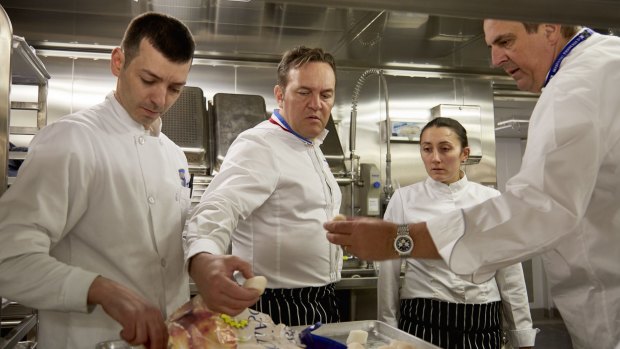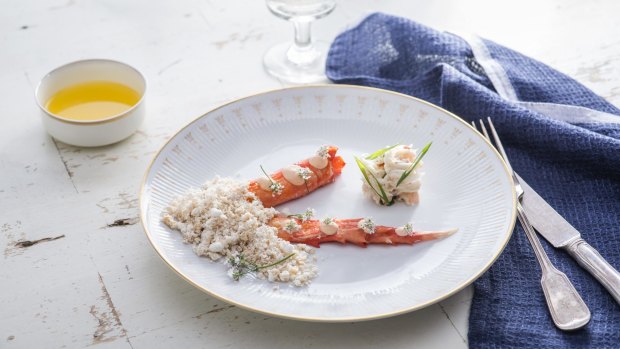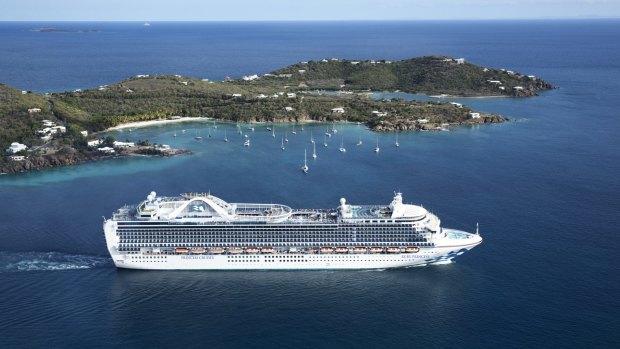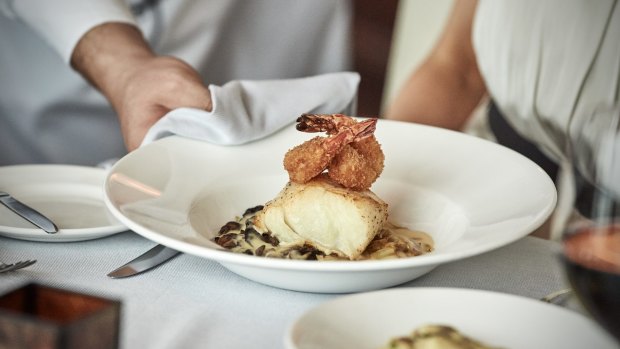This was published 4 years ago
Operating cruise ships: The volume of food needed on cruise ships
By Brian Johnston

Chef Emmanuel Renaut, La Mer Restaurant on Majestic Princess.Credit: Puxan BC
If the weekly shopping list on the world's largest cruise ship ever gets printed out, it must curl like ticker tape down corridors and across decks. I imagine you'd need a wheelbarrow to haul it to the shop, and a convoy of trucks to carry your goods back to the ship when you're done. In fact, you'd probably need one truck just for the eggs: 60,000 of them, or 5000 cartons.
That's the number of eggs required on an average one-week cruise on Symphony of the Seas. Plus 5700 kilos of flour, 9000 kilos of potatoes, 680 kilos of coffee and much, much more. This Himalaya of food has to be loaded and stored. It has to turn up in the right galley at the right time. Then it has to be transformed into three meals a day for 8800 passengers and crew – a whopping 26,400 meals daily.
Cruise passengers seldom dwell on such matters on well-run cruise ships, where practicalities take place behind service doors. But I've always thought cruise ships a marvel of collective human organisation. As I lounge poolside, I sometimes speculate on the complexity involved in ordering even a simple burger. How did that humble pickle and lettuce get 500 miles out to sea and end up in my order?

Curtis Stone's roasted crab for Princess Cruises.
Meticulous planning is how. Take Ruby Princess, which has 15 dining venues for 3080 passengers. The ship loads 250,000 kilos of provisions every 14 days, including 60,000 kilos of fruit and vegetables and 100,000 eggs. Some ingredients come in small amounts, such as the nduja (a spicy spreadable sausage from Italy) and Murray River pink salt from Australia used by Curtis Stone in his specialty venue SHARE.
'It's imperative to assess how much stock is needed well in advance to ensure the produce loaded is sufficient for the entire sailing," explains Stone. "Unlike a restaurant kitchen, food is only restocked when the ship is in port. We also make sure to factor in anything that may affect a particular sailing, including the location of the voyage, which can impact what produce is available."
Talk to any cruise chef and they soon mention the challenges of provisioning, except in Europe, where good supply and short distances between ports makes life easier. But wherever the ship is, if an ingredient can't be found, the menu has to be rewritten. If a chef discovers three-quarters of his or her 2000-kilo order of cantaloupe melons spoiled on arrival in port, an alternative must be sourced. And while the market's mangoes might look enticing, a boxful isn't enough.

Ruby Princess in St Thomas, the Caribbean
Volume is a challenge. SHARE restaurant serves six-course meals to 150 guests, or 900 dishes daily, which would be the envy of a land restaurant. Variety of ingredients is challenging too. Nobody goes to the same restaurant several times a week unless they're at sea, which means cruise ship menus change frequently.
Crystal Cruises' Waterside restaurant, for example, never repeats a menu, even on a world cruise 100 days long. And its chefs have to source ingredients from far and wide: Russian caviar, French and Italian cheeses, Maine lobster, Alaskan crab. Speciality restaurant Umi Uma, helmed by Japanese-Peruvian fusion chef Nobu Matsuhisa, alone offers 23 types of fish and shellfish.
You need serious help for this endlessly repeated dinner party. Big ships have a dozen crew dedicated to managing its stores. A Crystal ship might have 65 chefs, a bigger Celebrity ship 162, a Royal Caribbean vessel 210. Some are specialists, such as the saucier (sauces and stocks), poissonier (fish), garde-manger (cold dishes) and patissiers.

Lobster dish from Princess Cruises' Sterling Steakhouse.
The most critical job might be mise en place, the preparation and arrangement of ingredients (some par-cooked) so that, when the orders start flying in, the chefs have everything they need on hand. As an added challenge, space for mis en place is often very limited in cramped and crowded galleys.
Big ships might have three galleys or commissary kitchens dedicated to the preparation of foods, which are then sent onwards to a dozen smaller kitchens closer to restaurants for cooking or assembly. Restaurants on medium-sized luxury ships typically have their own galleys with preparation areas and hot and cold sections.
The smaller the ship, the greater the challenge, despite the reduced guest numbers. The masted sailing ship Star Clipper (170 passengers) has a galley that runs 20 hours a day in a hot, windowless space no larger than a home kitchen. Eight chefs work with sharp knives amid hotplates and ovens, on surfaces that might roll or pitch.
Another challenge of cooking at sea? Cooking techniques have to be adapted. Because open flames are restricted, chefs resort to innovative cooking methods such as sous-vide circulators, smokers, air dryers, Thermomixes and evaporators.
"The movement on board coupled with the change in air temperatures and moisture can make dough work quite challenging," says Curtis Stone. "Chocolate work too is very dependent on the weather, where the ship will be positioned, and even the time of day. We take all these factors into account before we commence any chocolate work on board."
Not that Princess Cruises' passengers are worried. They just browse through the SHARE menu, tucking into butter-poached Alaskan king crab and duck leg confit, oblivious to how it ended up on their plate. They can finish off with a chocolate crémeux which – never mind the salt air or weather – always tastes good. It's the miracle of dining at sea, from the not-so-humble shopping list to pleasure on a plate.
WHAT THE INSIDERS SAY
CURTIS STONE, CELEBRITY CHEF, PRINCESS CRUISES
Due to safety rules, we're not allowed the use of gas stoves or open-flame barbeques. Instead, everything is electric, so we have to make sure all recipes are suitable for this cooking method. And we make adjustments if we experience unfavourable weather conditions. When cooking pasta in rough seas we'll only fill a pot of boiling water a quarter of the way, which can make cooking more than one order of our Ricotta Cavatelli a little more challenging. See princess.com
PETER DEGNER, EXECUTIVE CHEF, CRYSTAL SYMPHONY
I work closely with the stores manager to keep the pantry stocked. We need enough supplies for 1,400 breakfasts, lunches and dinners daily and, on an average cruise, produce 150 different main courses, plus themed lunch buffets, a Viennese dessert buffet and late-night gourmet snacks. Guests typically consume over 23 kilos of caviar, 1,800 kilos of fish, 30,000 eggs, 135 kilos of strawberries and well over four tons of bananas, oranges, mango, papaya and melon. See crystalcruises.com
LAURANT TRIAS, EXECUTIVE CHEF, OCEANIA MARINA
The ship's bakery works 24 hours a day. At night, the dough, cookies and cake bases are made for the next day. Then during the day, the cakes are finished and decorated. We use 1,250 kilos of imported French flour daily just in the bakery, and 450 litres of milk. Making consistently good baguettes and croissants is a challenge, because the temperature and humidity in the air are so different in destinations such as Polynesia and Alaska. See oceaniacruises.com
MARK TOMLEY, FOOD & BEVERAGE DIRECTOR, CELEBRITY CRUISES
Our Aussie and Kiwi guests are more health conscious than passengers from elsewhere. We prepare for our Australian season by catering to some of the unique tastes found down under, and increase quantities of locally-sourced produce such as fish, lamb, eggs and wines from Australia and New Zealand. Our on-board café prepares for an influx of coffee aficionados, with double the amount of coffee consumed during Australian sailings. See celebritycruises.com.au
TRACY GREINER, HOTEL MANAGER, STAR CLIPPER
Turnover port is the day we have the opportunity to get our supplies on board, which must all be certified produce from countries that support our standards. It has to be loaded quickly, because every hour a lettuce sits on the dock, it loses a day of shelf life. We generate fresh-food orders 10 days beforehand with our forecast of passenger numbers, and also receive a frozen and dried food container from Europe. See starclippers.com
Sign up for the Traveller Deals newsletter
Get exclusive travel deals delivered straight to your inbox. Sign up now.